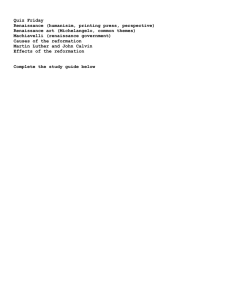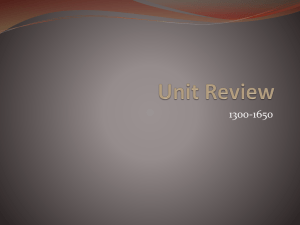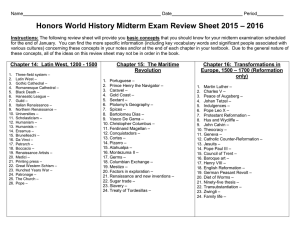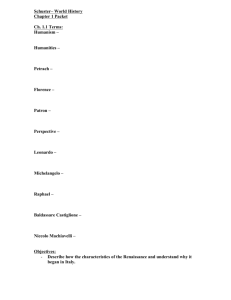Study Guide Part 1 - Loudoun County Public Schools
advertisement
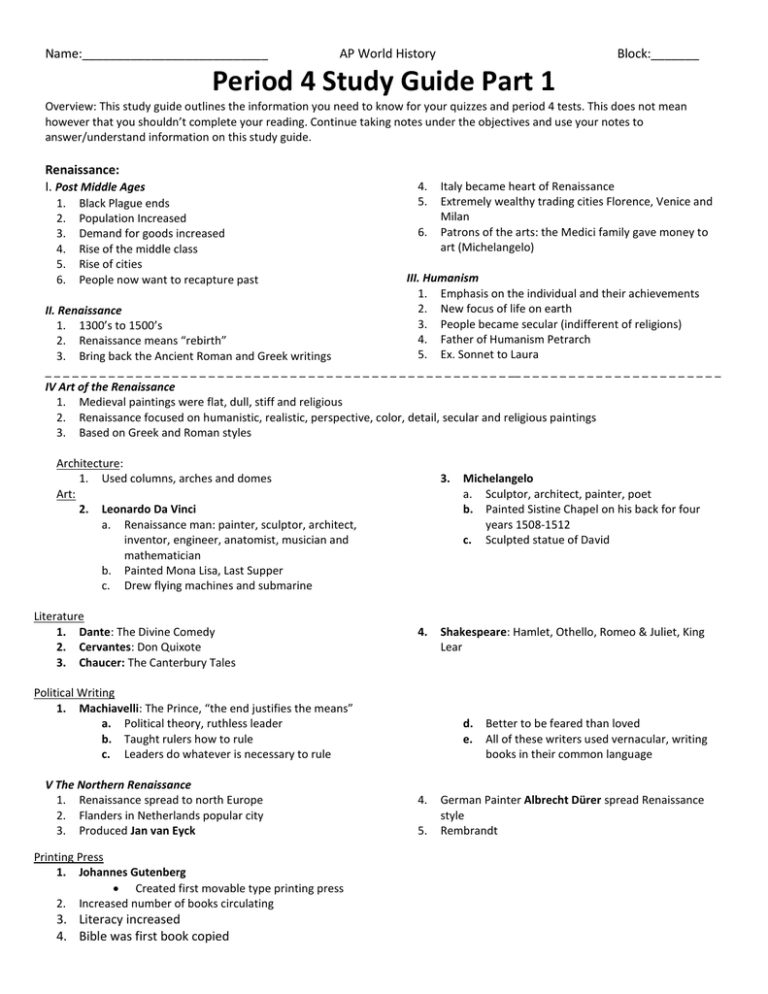
Name:___________________________ AP World History Block:_______ Period 4 Study Guide Part 1 Overview: This study guide outlines the information you need to know for your quizzes and period 4 tests. This does not mean however that you shouldn’t complete your reading. Continue taking notes under the objectives and use your notes to answer/understand information on this study guide. Renaissance: I. Post Middle Ages 1. 2. 3. 4. 5. 6. Black Plague ends Population Increased Demand for goods increased Rise of the middle class Rise of cities People now want to recapture past 4. 5. 6. Italy became heart of Renaissance Extremely wealthy trading cities Florence, Venice and Milan Patrons of the arts: the Medici family gave money to art (Michelangelo) III. Humanism 1. Emphasis on the individual and their achievements 2. New focus of life on earth II. Renaissance 3. People became secular (indifferent of religions) 1. 1300’s to 1500’s 4. Father of Humanism Petrarch 2. Renaissance means “rebirth” 5. Ex. Sonnet to Laura 3. Bring back the Ancient Roman and Greek writings _ _ _ _ _ _ _ _ _ _ _ _ _ _ _ _ _ _ _ _ _ _ _ _ _ _ _ _ _ _ _ _ _ _ _ _ _ _ _ _ _ _ _ _ _ _ _ _ _ _ _ __ _ _ _ _ _ _ _ _ _ _ _ _ _ _ _ _ _ _ _ _ _ _ IV Art of the Renaissance 1. Medieval paintings were flat, dull, stiff and religious 2. Renaissance focused on humanistic, realistic, perspective, color, detail, secular and religious paintings 3. Based on Greek and Roman styles Architecture: 1. Used columns, arches and domes Art: 2. Leonardo Da Vinci a. Renaissance man: painter, sculptor, architect, inventor, engineer, anatomist, musician and mathematician b. Painted Mona Lisa, Last Supper c. Drew flying machines and submarine Literature 1. Dante: The Divine Comedy 2. Cervantes: Don Quixote 3. Chaucer: The Canterbury Tales 3. 4. Political Writing 1. Machiavelli: The Prince, “the end justifies the means” a. Political theory, ruthless leader b. Taught rulers how to rule c. Leaders do whatever is necessary to rule V The Northern Renaissance 1. Renaissance spread to north Europe 2. Flanders in Netherlands popular city 3. Produced Jan van Eyck Printing Press 1. Johannes Gutenberg Created first movable type printing press 2. Increased number of books circulating 3. Literacy increased 4. Bible was first book copied Michelangelo a. Sculptor, architect, painter, poet b. Painted Sistine Chapel on his back for four years 1508-1512 c. Sculpted statue of David Shakespeare: Hamlet, Othello, Romeo & Juliet, King Lear d. Better to be feared than loved e. All of these writers used vernacular, writing books in their common language 4. 5. German Painter Albrecht Dürer spread Renaissance style Rembrandt Reformation I. Pre-Reformation a) Christian humanism: people wanted to reform Catholic Church b) Erasmus: criticized abuses in church and of Monks c) 1450-1520- corruption in church d) Pope’s corrupt with political power and greed e) III Martin Luther a. 1517 German monk b. rejected church practices c. posted the 95 theses on Wittenberg church d. he was against the sale of indulgences e. Claimed that faith alone will grant salvation f. Bible is the only source of truth g. Priests should marry h. Mass and sacraments done in all languages not just Latin IV John Calvin a. Follower of Luther b. Believed in predestination II. Church Abuses 1. 1500’s church needed money 2. Wanted to beautify the churches and pay Renaissances artists 3. Sold indulgences: instant salvation for money 4. Also raised prices on sacraments: marriage, baptism, etc. “Erasmus i. Asked by Pope Leo X to recant laid the egg j. He was soon excommunicated that Luther k. German princes protected Luther hatched” l. 1555-Peace of Augsburg m. German Princes chose religion of the state n. People could choose to be Catholic or Lutheran o. They could also move to a German state practicing their religion c. This was a belief that God had already chosen who will be saved d. Set up a theocracy in Geneva, Switzerland V King Henry VIII a. b. Wanted a male child, his wife didn’t have any c. Wanted a divorce but pope wouldn’t allow it d. He then blasted the pope and set up the Church of England VI Effects a. Loss of religious unity in Europe b. Thirty Years war 1614-1648 was a Religious conflict c. 1648 a truce was declared. d. It was agreed that a few countries including England, Scotland and Germany would stand as "Protestant" lands. e. The rest remained Roman Catholic. ________________________________________________________________________________________________ Counter Reformation I. Effects of the Reformation 1. Loss of religious unity in Europe 2. Paved the way for future revolutions 3. Religious conflicts II. Religious Wars 1. French wars of religion 1562-1598 2. Huguenots (French Protestants) vs. Catholics 3. 1598- Edict of Nantes o o England Henry VIII Wanted a male heir He was denied annulment by the pope Started the Anglican Protestant Church or Church of England Elizabeth I (Protestant) vs. Mary I (Catholic) Mary I also known as Bloody Mary Thirty-Years War Last religious war 1618-1648 Catholics vs. Protestants in Germany 4. 5. 6. New denominations: Lutherans, Amish, Quakers. Many wars occurred Church lost power 4. 5. This allowed Protestants to practice in Catholic France Also granted Protestants certain rights in France After Mary’s death Elizabeth makes England Protestant again Anglo-Spanish war 1585-1604 Spanish Armada 1588 (England wins) Phillip II vs. Elizabeth I. James I declares truce with Spain 1604 Ended with the Treaty of Westphalia which allowed princes to choose their religion III. The Counter Reformation 1. 16th century Church reforms 2. Banned the sale of Indulgences 3. Creation of the Society of Jesuits by Ignatius of Loyola 4. 5. Used to restore faith in the teachings of Christ Catholics should do good works and have faith IV The Council of Trent 1. Council of religious leaders that met from 1545-1563 2. The Church condemned Protestantism 3. Specified Catholic doctrines on salvation, the sacraments and the Biblical canon. They also set out to reform the abuses of the Church 4. V. The Inquisition i. Established by Pope Paul III in 1542 ii. Used to end heresies against the Church iii. Created the Index of Forbidden Books iv. List comprised of books that go against Church teachings __________________________________________________________________________________________________ Scientific Revolution I Pre-Revolution 1. Church was still main authority 2. Geocentric universe (earth-centered) II Copernican Theory 1. 16th century Copernicus 2. Mathematician challenged geocentric theory 3. Heliocentric model (sun-centered) III Galileo 1. Proves Copernican theory 2. Writes in Italian to reach bigger audience 3. First to use telescope to document the stars 4. Church summoned him to Rome IV Revolutionary Scientists 1. Scientific Method: uses observation, hypothesis, and experimentation 2. Tycho Brahe: built Europe’s most modern astronomical laboratory to gather data 3. Francis Bacon: inductive logic. This method involved experimentation, and the collection and analysis of data. V Advances in Inventions and Medicine 1. Zacharias Jansen invented the first microscope. 2. Evangelista Torricelli developed the first mercury barometer 3. Gabriel Fahrenheit developed the first thermometer 4. Anders Celsius developed another thermometer using a different 3. 4. Renaissance and Reformation challenge old views Many scientists now challenge theories 4. 5. Church calls it illogical, unbiblical and un-Christian Publishes book in the year of his death 5. He faced the Inquisition and Forced to recant his theories His writings placed on Index of Forbidden Books 6. 4. 5. 6. 7. 5. 6. 7. 8. Johannes Kepler: planets revolve around the sun in elliptical orbits Rene Descartes: deductive method, whatever could be doubted must be rejected “I think, therefore I am” Isaac Newton: Law of Gravitation, Calculus Andreas Vesalius studied human anatomy William Harvey the heart acted like the pump to circulate the blood Edward Jenner introduced the first vaccine to prevent smallpox. Robert Boyle considered modern father of chemistry VI Deism 1. Many people rejected god, became atheists 2. god who created and presided over an orderly realm 3. did not interfere in its workings. 4. God was a watchmaker, one who set up the world, gave it natural laws by which to operate, and then let it run itself ______________________________________________________________________________________________________________________________________________________________________________________________________________________________________________________________________________________________________________________________________________________________________________________________________________________________________________________________________________________________________________________________________________________________ Enlightenment I. Enlightenment 1. 16th, 17th and 18th centuries 2. Inspired by the Scientific Revolution 3. Age of Reason 4. People applied Logic and Reason to gov’t 5. During the High M.A, Renaissance most monarchs believed in divine right 6. 7. 8. 9. God ordained their right to rule Ex. James I of England 1603-1624 “The king is from god, and law is from king.” Different than the mandate of heaven II Enlightenment Theory A. 17th philosophes believe gov’t was made for the people (no divine right) Philosophe Thomas Hobbes Book Theory People are evil by nature Absolute Monarch should rule People had natural rights Life, liberty, and property Gov’t should represent people If they didn’t people could overthrow it All men were equal Majority rule, Direct democracy Inspired revolutions (French) Anti-slavery Separation of Powers Checks and balances Freedom of speech Religious toleration Helped spread Enlightenment ideas John Locke Jean-Jacques Rousseau Baron de Montesquieu Voltaire Diderot C. Enlightened Despots Frederick II Prussia-religious toleration, provided land and supplies for peasants Catherine the Great Russia- improved Russia, education, expansion Joseph II Austria- Peasant emperor, religious toleration, free speech D. Results o Inspired the French and American revolutions o Locke inspired Jefferson’s writing ________________________________________________________________________________________________________________________________________________________________________________________________________________________ European Exploration I European Exploration and Expansion o Trade linked through land routes: Persia, Arabia, Asia, Silk Road o Europeans had ships trade in Mediterranean Sea and Indian Ocean II Motives for Exploration o Europeans primary motive was economic o Desire for wealth and foreign goods III Portugal o Prince Henry the Navigator supported a navigational and sailing school o Started conquering small islands in Atlantic and cities on Africa’s west coast o 1488 Bartolomeu Diaz sails to the southern tip of Africa (Cape of Good Hope) IV Spain o 1492 Ferdinand and Isabella financed Christopher Columbus o Columbus sailed west and discovered the Americas V The Dutch o Dutch Gain independence from Spain o Begin to seize Portuguese lands o Set up Dutch East India Trading Company o Also explored and settled North America VI New Technology o Late 15th century new maps o Lateen sails: sail in all directions, good for monsoons o Astrolabe: Navigational device determines latitude o o o Wanted direct route to the east, rather than middlemen Atlantic Ocean was vastly unknown Wanted to sell foreign goods for profit o o o o o o o o 1497- Vasco de Gama was first European to reach India by sea Profit was 60 times more than the investment Ferdinand Magellan-Led the first successful expedition to circumnavigate the globe 1494 Treaty of Tordesillas Pope granted Spain all of North and South America Portugal received Brazil, Africa and India Henry Hudson sailed and claimed what is now New York Bought island of Manhattan o o o Magnetic Compass: Borrowed from China, used to tell direction Three-Masted Caravels: large ship, with larger sails Gun powder Conquistadors I. Cortes Cortes was a conquistador Wanted to conquer Mexico for gold Helped by Malinche Believed to be Quetzalcoatl Arrived receiving gifts eventually turned on the Aztecs II. Pizzaro Wanted to conquer the Incas He also wanted gold and riches Captured ruler of Inca III. Treatment of the Indians Bartolomé de Las Casas Defended the Indians Captured Montezuma When Montezuma died, Cortes teamed with other tribes to defeat the Aztecs He was considered a Hero, became famous and very rich Atahualpa promised 13,420 pounds of gold and 26,000 pounds of silver Pizzaro killed him anyway Incan Empire fell Bartolomé de Las Casas: accounts of the acts that the Spanish colonists inflicted This included hanging them, roasting them on spits, hacking their children into pieces Triangular trade/ Colonies I. First Encounters 1. Columbus landed in the Caribbean. 2. Conquistadors or conquerors seized gold 3. They enslaved the Indians and made them slaves 4. Forced Indians to convert to Christianity. II. Columbian Exchange 1. Columbian Exchange as it was known was the exchange of peoples, plants, animals, technology, and disease between the Eastern and Western hemispheres. 2. New products like corn, potato, sugar, horses, and other animals shifted 3. Disease: yellow fever, malaria, smallpox and the measles to the Americas Syphilis was brought to Europe Over 45 million Indians were killed due to harsh treatment and disease 4. 5. III. Ruling the new Empire Government: 1. Created the Council of the Indies to pass laws for the colonies. 2. Viceroys or representatives who ruled in his name in each province Religion: 1. Catholic Church converted thousands of Native Americans to Christianity. Economy: 1. New colonies could only export goods to Spain and only import goods from Spain. 2. Could not trade with any other country or any other colony. 3. Spanish were granted encomiendas. New Social Classes: 1. Peninsulares: people who were born in Spain. Highest positions in gov’t and Church. 2. Creoles, American born descendants of Spanish. Creoles owned ranches, plantations and mines. 4. This gave the Spanish the right to demand labor or tribute from the natives. 5. Worker shortages started African slave trade 6. They were immune to tropical diseases and skilled in farming, mining and metalworking. 3. 4. 5. Mestizos people of Native American and European descent Mulattoes people of African and European descent. At the bottom of society were the Native Americans and Africans. Absolute Monarchies I. New Government o Divine Right of Kings: kings ruled because they were chosen by God to be kings. o Autocracy, or rule by a single person. o Absolutism: monarch ruled with "absolute" power, that is, unshared power France I. Henry IV 1589-1610 Converted to Christianity Edict of Nantes in 1598 Gave the Protestants religious tolerance Ended the Wars of Religion in France Public works like improving roads Encouraged education assassinated in 1610 Ruled France for 72 years, longer than any other monarch in European history Rebuilt of culture: theatre, music, architecture, painting, sculpture, and all the sciences Palace of Versailles II. Louis XIII o Ruled with Cardinal Armand Richelieu o Richelieu protected and strengthened royal authority III. Louis XIV King at 4 Cardinal Mazarin helped Louis rule known as the Sun King Appointed intendants: officials collected taxes and carried out royal policies Made French army strongest in Europe IV. Negative Effects of Louis XIV’s Rule 1. Wars of Louis XIV were costly 2. Cancelled Edict of Nantes and forced out 100,000 artisans and workers 3. War of the Spanish Succession (1701-14) 4. 5. France and Spain would remain separate Died 1715 leaving France with many problems that will eventually cause a revolution Great Britain II English Absolute Monarchs A. Elizabeth I Elizabethan Age: 1558-1603 Golden age Commercial expansion, exploration, Colonization of New World B. James I Combines thrones of England and Scotland Claimed divine right. C. Charles I Took over in 1625 Signed the Petition of Right Limited taxes and forbid unlawful imprisonment. Claimed divine right Scotland soon invaded England in 1640 Long Parliament 1640-1660 Limited the power of the monarch Civil war in England. Roundheads led by Oliver Cromwell win Charles I was executed D. Oliver Cromwell Lord Protector of English Commonwealth Religious intolerance and violence Protects people from arrests without due process Charles II was a closet Catholic and converted on his deathbed Signed the English Bill of Rights in 1689 Gave citizens certain rights Roman Catholics could not be king or queen of England Limited the power of the monarch E. Charles II Reinstated a limited monarchy Known as the Stuart Restoration Habeas Corpus Act 1679 F. James II James II was openly Catholic Claimed divine right and was last Catholic monarch Glorious Revolution in 1688 James II was driven out, William and Mary the Protestant in

